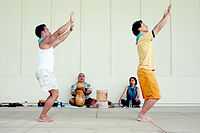Ipu

Ipu /ˈiːpuː/ is a percussion instrument made from gourds that is often used to provide a beat for hula dancing.
There are two types of ipu, the ipu heke /ˈiːpuː ˈheɪkeɪ/ and the ipu heke ʻole /ˈiːpuː ˈheɪkeɪ ˈoʊleɪ/. Both are made from gourds that have been cut off at the neck and hollowed. The ipu heke is two such gourds joined together with a hole cut in the top to allow the sound to escape. Ipu are usually polished smooth with sand or sandpaper.
Chants and dances in ancient Hawaii were accompanied only by percussion instruments. This art was suppressed after the arrival of Christian Missionaries in 1820, but revived under King David Kalākaua during his reign of 1874 to 1891.[1]
One form of Ipu art developed solely on the island of Niʻihau.[2][3] In this method, a design is carved in the skin of a fresh gourd, after which the gourd is filled with dye or other liquid coloring agent which, allowed to remain in the gourd for several weeks, changes the color of the uncarved portions of the surface of the gourd where its skin has remained intact.
Notes
- ↑ "About King Kalākaua". 2009.
- ↑ Jennifer Crites (October–November 2007). "The Ipu Guy". Hana Hou! Vol. 10 No. 5. Retrieved 2007-10-18.
This method developed [circa AD 1600] only on Niʻihau—nowhere else in the world—and then vanished at the end of the 19th century,” explains Harburg. “It was lost until Dr. Bruce Kaʻimiloa Chrisman figured out how it was done.
- ↑ Kris Bordessa (2007). "The Lost Ipu Art of Niʻihau". Craft: Vol. 4. Retrieved 2007-10-18.
References
- Implements/Instruments Database. Hula Preservation Society. URL accessed on November 28, 2005.
- About Gourds. The Gourd Connection. URL accessed on November 28, 2005.
- Ka`ahele Hawai`i"Na Ipu o Hawai`i, the Gourds of Hawai`i."